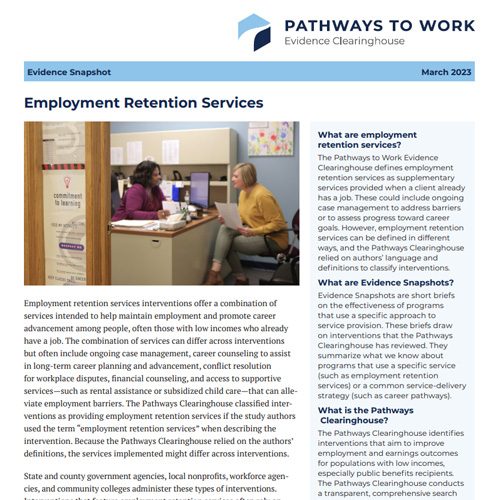Introduction
Employment retention services interventions offer a combination of services intended to help maintain employment and promote career advancement among people, often those with low incomes, who already have a job. This Evidence Snapshot summarizes what rigorous research tells us about nine interventions that used employment retention services as their primary service and the interventions’ impacts on earnings, employment, the receipt of public benefits, and education and training. The data come from 19 high- or moderate-quality studies that began between 1994 and 2005, were published through 2019, and were reviewed by the Pathways to Work Evidence Clearinghouse.
Primary Research Questions
- What does the evidence say about employment retention services interventions for people with low incomes?
- Do employment retention services interventions increase earnings, employment, education or training, and do they reduce the receipt of public benefits?
- What are the most effective employment retention services interventions?
Purpose
This Evidence Snapshot describes the effectiveness of programs that were identified by the Pathways Clearinghouse as using employment retention services as their primary service. It summarizes what we know about these programs and their impacts so TANF administrators, policymakers, researchers, and the general public can apply the evidence to their context and the questions that matter to them.
Key Findings and Highlighs
On average, interventions that use employment retention services produced modest improvements on outcomes and had the largest effects on earnings. In particular, for intervention participants -- as compared with comparison groups that did not receive intervention services --
- Short-term annual earnings increased by $818, and long-term annual earnings increased by $671, on average, across the 9 employment retention services interventions for which these outcomes were examined.
- Short-term and long-term employment increased by one percentage point, on average, across the nine employment retention services interventions for which these outcomes were examined.
- The proportion of people receiving public benefits did not change in the short term or long term, and the amount of annual public benefits received decreased by $11 in the short term and $34 in the long term, on average, across the 8 employment retention services interventions for which these outcomes were examined.
- Most of the 19 studies of employment retention services interventions reviewed for this snapshot did not assess effects on education and training attainment; therefore, we do not know whether most employment retention services interventions affected these outcomes. Education and training attainment increased by 3.3 percentage points for the 1 employment retention services intervention for which this outcome was examined.
- Two employment retention services interventions improved more than one type of outcome.
- One intervention had effects that were not supported in three domains. One intervention had effects that were not supported in two domains.
Methods
The Pathways Clearinghouse assigned an effectiveness rating to each intervention in each of four outcome domains: earnings, employment, public benefit receipt, and education and training. The rating describes whether the intervention is likely to produce favorable results in that domain if faithfully replicated with a similar population.
For this snapshot, the Pathways Clearinghouse calculated the average impact for each domain by averaging impacts within moderate- and high-quality studies, then within interventions (because there may be multiple studies on a single intervention), and then across employment retention services interventions. The average includes all studies, not just those with a supported rating or statistically significant findings, because these studies still provide useful evidence in considering the overall effectiveness of employment retention services.
This snapshot describes the interventions using employment retention services that had positive impacts on earnings, employment, public benefit receipt, and education and training, and highlights interventions that were effective in multiple outcome domains.
Citation
Fumia, Danielle, Olivia Mirek, and Erin Welch. (2022). Evidence Snapshot: Employment retention services, OPRE Report #2022- 270, Washington, DC: Office of Planning, Research, and Evaluation, Administration for Children and Families, U.S. Department of Health and Human Services.
Glossary
Employment retention services: The Pathways Clearinghouse defines employment retention services as supplementary services provided when a client already has a job. These could include ongoing case management to address barriers or to assess progress toward career goals.
Primary service: An intervention’s primary service is the principal service of the intervention. The primary service is (1) a component that a large proportion of intervention group members received and a large proportion of comparison group members did not and (2) the component that was described by the study authors as most integral to the theory of change tested by the study. Interventions may provide multiple services, but only one service is designated as primary.






